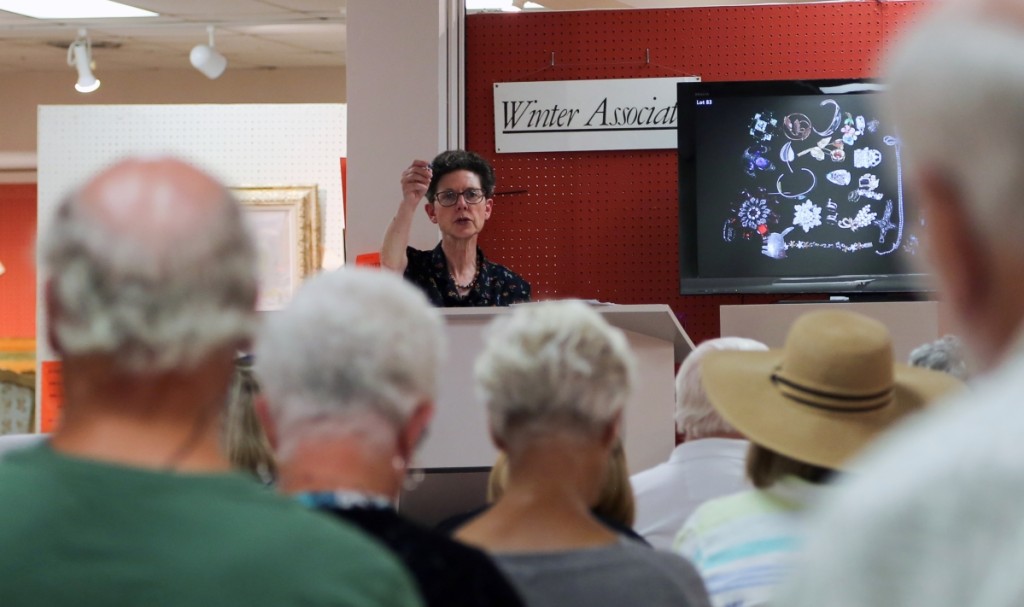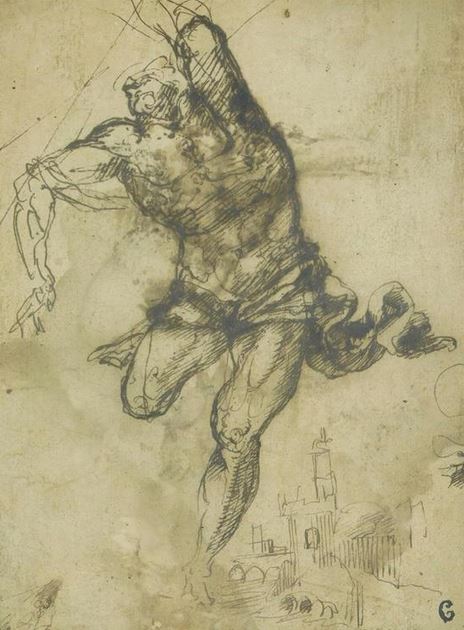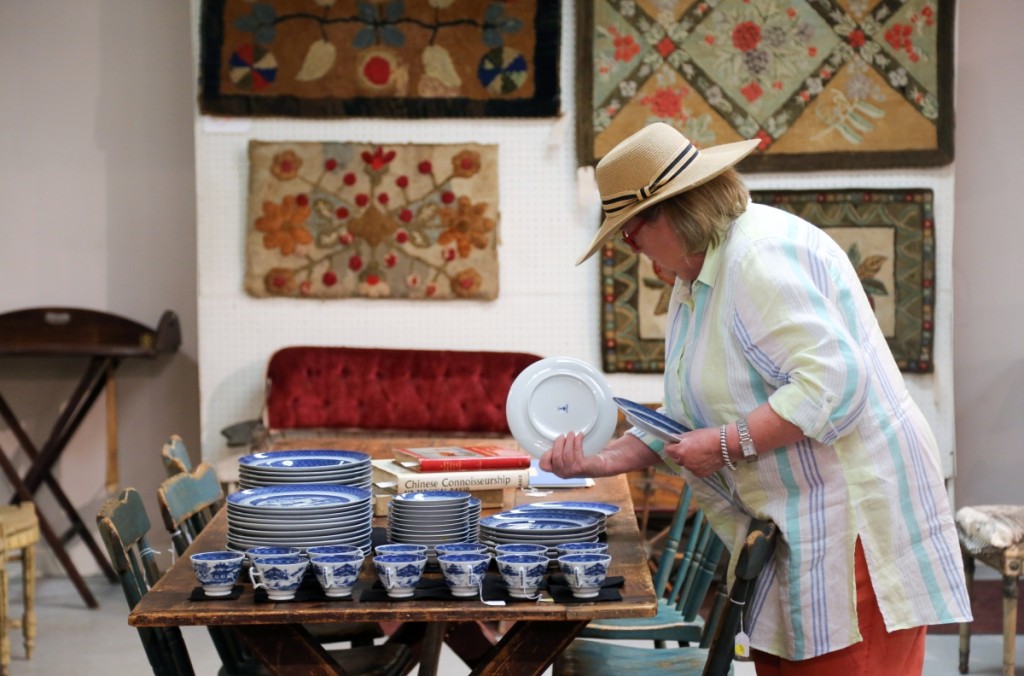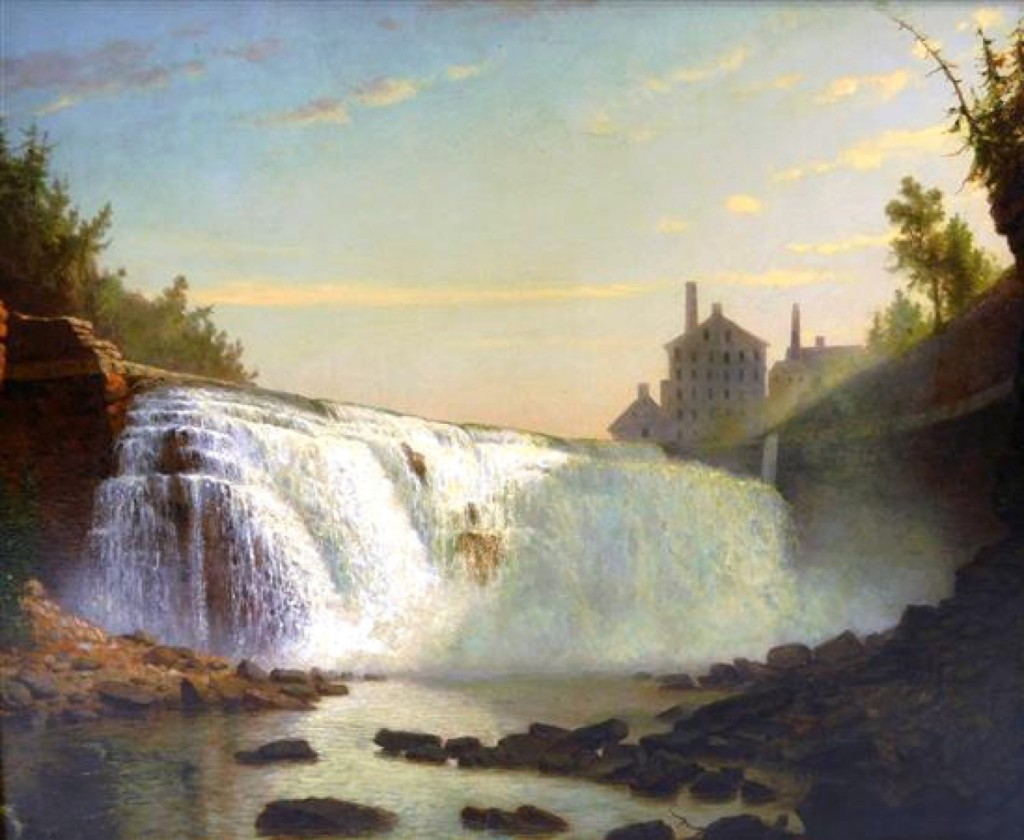
Linda Stamm calls the sale from the podium. Following the start of her firm four decades ago, Stamm recalled practicing auctioneering in her car to get the process right. Now a true veteran, Stamm is quick to command bidding here for her July 15 sale, where approximately 50 people sat in the gallery.
Review and Photos by Greg Smith
PLAINVILLE, CONN. – When Linda Stamm coincidentally met two women in the antiques business in the late 1970s, she could not have dreamed that it would turn into a 40-year (and counting) run at Winter Associates, the auction house they would go on to create.
The firm began in 1979 with a connection through a friend of a friend that led Linda Stamm to lunch with Helen Winter and Regina Madigan. Stamm, young and ambitious, had just finished school and returned from Europe with hopes of working in the antiques and art business, while Madigan had just moved down from New Hampshire to Connecticut and was looking for work. Winter owned and operated an antiques destination known as The Grist Mill on the Farmington River. She formed a small complex within the historic mill that would house a book shop, a needlepoint shop, a restaurant and her antiques shop, which focused on early American furniture and other things that would have furnished an early American home. Winter provided the name recognition for the auction firm, as she had been in business for a while at this point and did shows including some in New York City. Helen Winter & Associates was born.
“When we first started, we didn’t know how to be an auctioneer,” Stamm said. “So we hired one. There was an auctioneer out of Massachusetts, Mark Pollack, and we had him for a while.” Though Stamm soon realized that Pollack didn’t have the familiarity with the objects that one gains from seeing them in the house, cataloging them and offering them for sale. Stamm soon found herself in her car, practicing “25, 50, 75,” so that the numbers would roll off the tongue without thought. She made her way to the podium, cutting her teeth on the last 25 lots in each sale and soon after she was the full-blown auctioneer.
Helen Winter stayed with the firm for around four years before leaving it to Stamm and Madigan. The auction house rebranded into Winter & Associates so as to not lose the recognition they had found with buyers. Madigan left in 1995, leaving the business to Stamm, who became sole owner.
Now a veteran auctioneer and appraiser, Stamm feels that her curiosity and openness towards lifelong learning provided for a natural love of the business. “It’s for anybody that loves discovery,” she said, before her July 15 sale got underway. “You can get as excited in an attic about a $50 doll as a big hit. You never know. Even with the internet, we’re constantly learning and being exposed to things.”

The sale’s top lot was this late Sixteenth Century Forentine school drawing that brought $24,000. It was bought by a Parisian bidder.
The July 15 sale was primarily from two estates, one just over the southern border of Massachusetts and the other from Old Lyme, Conn. The Massachusetts estate came from an older couple downsizing homes and included much of the Americana on tap, things like painted pine furniture, gameboards and small carvings. The Old Lyme estate hailed from a collector who had moved to Connecticut following a life in New York City. The collector had a taste for Continental style found within Fifteenth and Sixteenth Century Dutch drawings, European furniture and other decorative accessories.
“I would say the sale was a nice success,” Stamm said following the auction. The auctioneer noted that the sale had more than 4,100 bidders registered on Invaluable who accounted for purchases on about one-third of the lots on offer.
The top lot of the auction was found at $24,000 in a late Sixteenth or early Seventeenth Century Florentine school drawing of a loosely drawn male athletic figure in motion above a more primitively drawn cityscape. The 8½-by-6-inch drawing was done in brown ink on dark cream paper.
Via gallery tag on the back, the work featured provenance to the Este Gallery, a New York City gallery operating in the 1950s-60s. The gallery labeled the work as the hand of Francesco Vicentino. The given dating on the tag, circa the Sixteenth Century, seems to align with the Milanese artist who was, according to A Biographical and Critical Dictionary of Painters, Engravers, Sculptors and Architects (Spooner, 1852), “highly commended by [Giovanni Paolo] Lomazzo for the excellence of his landscape, in which ‘he imitated nature so accurately as to show the dust blown about by the wind.'” The listing also says he was possibly a student of Cesare Bernazano and mentions he was a good figure painter.
A mark in the bottom right corner of the drawing aligned with the known mark for the Seventeenth-Eighteenth Century Parisian collector Pierre Crozat. According to The Drawings Collection of Pierre Crozat (1665-1740), (Hattori, 2003) Crozat’s Old Master drawings collection was one of the most important in France at the beginning of the Eighteenth Century. The Este tag on the back also referenced two other collections by last name only: “Ottley,” possibly referring to William Young Ottley, an Eighteenth-Nineteenth Century English collector, art writer and keeper of the department of prints and drawings at the British Museum; and “Reynolds,” possibly referring to Sir Joshua Reynolds, an Eighteenth Century English painter who amassed a considerable Old Masters collection. After spirited bidding, the work rose well above the $750 high estimate to sell to a bidder in Paris, who also purchased two other early drawings.

A previewer takes a look through a 74-piece Mottahedeh porcelain set in the “Blue Canton” pattern. It sold for $1,408.
Other top earners from this collection included a brown and ink wash drawing of a “Head of a Bearded Man” done by an artist in the circle of Agostino Carracci (Bologna/Parma 1557-1602). The work sold for $3,480. An ink drawing attributed to French Seventeenth Century artist Raymond Lafage featuring the Procession of Pan would triple the $800 high estimate when it sold for $2,432. Other works from the collection were affordable, including an Eighteenth Century Florentine ink drawing featuring a study for “Massacre of the Innocents,” the New Testament narrative in the Gospel of Matthew where King Herod orders the execution of all male children two years old and younger. That drawing sold for $615, near its high estimate. A Seventeenth Century Italian drawing in red pencil depicting three portraits of young women went out at $704.
Other works of fine art fared well, particularly New York scenes, including a John Carlin (American, 1813-1891) oil on canvas featuring the lower falls of the Genesee River in Rochester, N.Y., in 1887. The painting was earlier purchased by the consignor from Godel & Co for $15,000 in 2004 and it sold in this sale for $4,200 to a buyer from New York.
Two New York City snow scenes from American artist Johann Berthelsen (1883-1972) finished between estimates. Stamm had appraised the two American Impressionist pieces years ago and at that time spoke to the artist’s son, Lee Berthelson, about them. She was able to include some further information about the works as a result. At $4,200 was a 15½-by-11½-inch oil on canvas that the artist’s son confirmed the title to be “Grand Army Plaza, Fifth Avenue.” The painting features prominently the Bergdorf-Goodman Building with five windows on the Mansard roof, which would date this painting between 1930 and 1940. In the 1950s, two additional windows were added to the roof. Behind at $3,240 was “Central Park Looking South,” a 11½-by-15½-inch oil on canvas circa 1967-72. Both of these paintings featured the artist’s son and the family dog, Wags.
American furniture found a prize winner in an Eighteenth Century Massachusetts mahogany block front slant lid desk as it sold for $9,600, batting between a floor and an internet bidder. The internet won. The piece reportedly had verbal provenance to Colchester, Conn., dealership Nathan Liverant and Son. From the same consignor was a Chippendale side chair, circa 1780, with a shell crested pierced slat, molded apron and legs and a needlework covered seat that would bring $420. Following closely behind at $384 was a Massachusetts mahogany Hepplewhite side chair, circa 1790, with tapered legs and a Federal pierced splat with a carved fan base. At $720 was an American Empire carved crotch mahogany tester bed with heavy turned posts and chintz fitting and bedcovers.
Painted furniture had its share of affordable buys, including a Pennsylvania pine blue painted dough box with a lift lid over two doors, which took $600. A circa 1730 New England painted pine blanket chest with later decoration brought only $125. Meanwhile, a red and black gameboard paired with a carved and painted crow would fetch $540 over a $150 high estimate.

This John Carlin (American, 1813–1891) oil on canvas painting depicts the lower falls of the Genesee River in Rochester, N.Y., in 1887. The work sold for $4,200 to a New York buyer.
Porcelain, even some of the earliest manufactured examples in America, turned out to be a tough sell at the auction. Three pairs of pitchers, with low estimates of $3,000, $1,500 and $800, would not budge off the block. They were from the Philadelphia-based Tucker Porcelain factory, produced under William Ellis Tucker, which operated from 1826 to 1838. Tucker is believed to be the first domestic manufactory to picture American scenes at a time when British and French porcelain was both cheaply produced, imported and en vogue. Only some of the midrange Tucker pieces would sell, the highest being a 10-inch-diameter gilt and enameled porcelain footed bowl with floral decoration that brought $704.
A cache of militaria dating back to the Civil War gained some interest among bidders. Chief among them was a wooden round canteen with a leather strap and a hand carved inscription which read “J B Tubbs/ C A 10th Regt.” The canteen went out at $1,845. Three percussion revolvers, a musket and a rifle all followed. At $1,140 was a single action revolver from the Savage Arms Co, circa 1860; a Starr Arms Co, N.Y., single action percussion revolver, circa 1860, $1,024; an Enfield Tower Three Band .58 caliber rifle, circa the 1860s, $960; an 1860s Colt .44 revolver with horn, $1,080; and an 1860s flintlock militia musket, probably Dutch and approximately .80 caliber, $1,440.
“We have some wonderful pieces of silver in this sale,” Stamm remarked before the sale got underway. And almost none of them disappointed as they sold around the country to Wisconsin, Mississippi and Miami. An I.W. Forbes three-piece coin silver set, circa 1885, consisting of a lidded pot, covered sugar and a creamer, each with repoussé handles and shell and flower chased borders, went out between estimate at $1,920. Three sets of silver flatware followed: a 50-piece Gorham “St Cloud” pattern set brought $2,040; a Tiffany & Co., “Chrysanthemum” pattern designed by Charles Grosjean, circa 1880, and featuring 32 pieces, $1,900; and a Tiffany & Co., “Saratoga” pattern set, circa 1870, 47 pieces, brought $1,664. A set of unmatched six serving pieces from various makers, including Gorham, Wood & Hughes, George Webb and others would take $1,088.
As of now, Linda Stamm has not thought about slowing down. “I love what I do and I hope to continue doing it,” she said. “And it’s impossible to do this without the incredible support from the staff. Everybody here is dedicated to having happy consignors and happy purchasers. I like to think that, of course, we sell objects, but we really are a service. Somebody has an object to sell and we try to get it to someone who wants to own it.”
Prices, with buyer’s premium, as reported by the auction house.
For additional information, www.auctionappraisers.com or 860-793-0288.



























